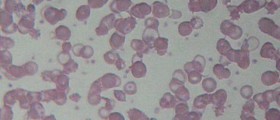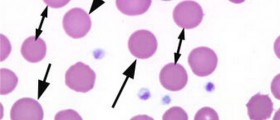
Sickle cell anemia is a genetic disorder affecting the blood, to be more precise red blood cells. Red blood cells (erythrocytes) contain hemoglobin, a compound that binds oxygen and allows its transmission to all cells in the body. Red blood cells are of specific appearance (round in shape) and are able to squeeze through body's capillaries in order to perform their duty. In people suffering from sickle cell anemia both the shape and texture of red blood cells change which makes them more fragile and susceptible to trauma. They are sticky and shaped like sickles or crescents. Due to all the mentioned sickle cell anemia patients have to deal with premature dying of their red blood cells and all the associated health issues.
Sickle Cell Crisis and Potential Complications
In sickle cell anemia red blood cells are prone to sticking. These clusters of cells easily clog blood vessels of smaller diameter which subsequently leads to oxygen deprivation. Clogging is associated with episodes of moderate to severe pain and is known as sickle cell crisis.
Inadequate oxygen supply may be responsible for different degree of tissue/organ damage. Because of that sickle cell anemia may be initiator of several complications. For instance, patients may end up with a stroke, suffer from frequent and serious infections and develop acute chest syndrome.Sickle Cell Anemia Causes
This medical condition is characterized by an abnormal type of hemoglobin (hemoglobin S). The protein is responsible for changes in the shape of red blood cells.
Sickle cell anemia is a genetic condition and is inherited from both parents. In case an individual inherits the hemoglobin S gene from one parent and normal hemoglobin gene from another, he/she will not develop the disease, but become a carrier instead. These individuals have sickle cell trait.
Outlook
While a certain number of patients deal only with mild symptoms of the disease, others have frequent sickle cell crisis and eventually end up with many complications.
In spite of major advances when it comes to the treatment for sickle cell anemia, the disease itself as well as its complications sometimes remind life-threatening. Today, fortunately, complications may be properly prevented and even timely diagnosed. Because of such improvement today people with the disease live much longer than they used to. It is estimated than the average life expectancy in individuals suffering from sickle cell anemia ranges between 53 and 60 years of age.
Prevention
Since sickle cell anemia represents a genetic disorder, currently there are no efficient ways of its prevention. On the other hand, if the condition occurs, certain precautionary measures may prevent a sickle cell crisis. Unfortunately, these measures are not efficient in all patients so certain number still have to deal with frequent episodes of pain and other health issues.

















Your thoughts on this
Loading...